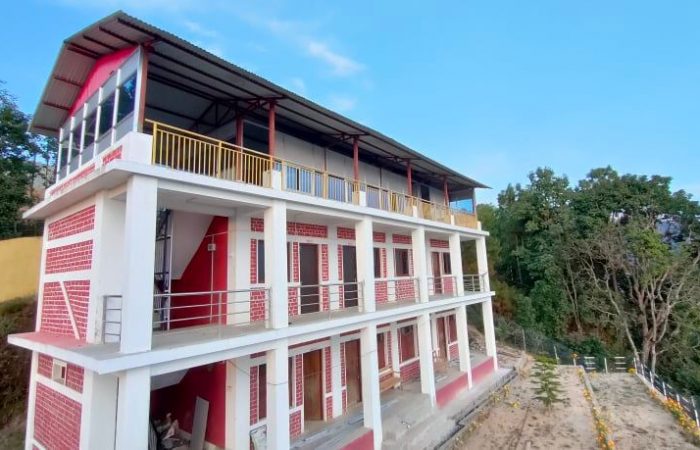Bhojpur: An introduction
Bhojpur is a remote district of the mid- hills which falls in Koshi zone of the eastern development region, among five development regions of Nepal. This district is surrounded in the east by Sankhuwasabha and Dhankuta, in the west by Khotang, in the north by Solukhumbu and in the south by Udayapur. The district occupies 1.02 percent of the total area of Nepal, 5.30 percent of eastern development region and 15.59 percent of Koshi zone. The district which lies at an altitude of 153 m to 4153 m above sea level is spread from 26° 53’ north – 27° 46’ north latitude and from 86°53’ east to 87° 17’ east longitude.
Bhojpur district has 93 kms of north – south average length and 35 km east – west average width is spread north – south and has its central part a bit wider.
The district has a diversity of climate and natural vegetation because of geographical diversity. It has a climate ranging from alpine to tropical monsoon climate. As the district has red, grey soil, the land is mostly dry.
Bhojpur has 41.29 % of total land of the district as arable land, 50.29 % forest area, 3.67% pastures, and 4.75 % land as rivers, stony and cliffs and slopes.
This district has a maximum temperature of 32.2° C and minimum 0.10° C, relative humidity 90% in rainy season and 50-70% in winter and receives a rainfall of 1005.9 mm to 2123.1 mm annually.
A tributary of Saptakoshi river, Arun, flows down in the eastern border of Bhojpur, and Sunkoshi river in the southern border, whereas there are various other main rivers and streams, such as Pikhuwa, Irkhuwa, Chirkhuwa, Chhintalung, Buwa, Juke, Siktel, Kawa, Newasukhe, Ghatte, Balkhu, Hangrayo, Khakuwa, Behere and Sisuwa flow within the district.
Salpa Pokhari is the largest lake in the district, located at Dobhane VDC of northern Bhojpur, whereas Panchakanya, Hanshapokhari, Chyangre Pokhari are major ponds here. Likewise, the waterfall of Chirkhuwa River is the largest waterfall of the district.
The tourism attractions of the district are Siddhakali Temple, Taksar Bazaar, Temke hill, Selme and Suntale hills, Dingla township, Mayum (Maiyun) hill, Silichang, Hatuwagadhi (fort) and Salpa Pokhari etc.
The karuwa (spout) water jar and Khukuri (famous Gurkha knife) made here have not only earned national but also international fame.
As Kirant (RAI) communities started living in this area 2000 years ago, still there is a majority of Kirant community living here. The Majh Kirant is the origin of the Kirant civilization and culture.
The Awal Bramhachari Balaguru Shadananda of Dingla in Bhojpur established a Sanskrit Pathshala (school) in Dingla in 1932 BS, which is the first school in the country established in the people’s level in Nepalese history. Presently, the school has been running with the name “Shadananda Higher Secondary School”. Likewise, Vidyeswor Sanskrit Pathshala was established in Gogane of Bhojpur in 1998 BS, and such schools were established in Taksar, Falikot and other places, whereas the Jyotideep Education Centre of Batase, Siktel, and Katunje had also earned fame.
The economic resources of this district depend mainly on agriculture. Although economically active population is 63.82%, 89.45 % of them are dependent on agriculture and 10.55 % in non – agricultural occupations.
The total area of Bhojpur district: 1522 Sq.km
The highest point in the district: Silichung (4153 m)
The lowest point in the district: Hasanpur (153 m)
District headquarters: Bhojpur (1540 m)
Major Rivers, Lakes and Ponds
- Arun River, Sunkoshi, Pikhuwa Khola, Irkhuwa Khola, Chirkhuwa Khola, Chhintalung, Buwa, Juke, Siktel, Kawa, Newasukhe, Ghatte, Balkhu, Hangrayo, Khakuwa, Behere, Sisuwa, Yang Tang, Wachingle, Hinkhuwa and Sera rivers.
- Salpa Pokhari, Panchakanya, Hansha Pokhari, Bhabisyabakta Pokhari (forecaster pond) and Chyangre Pokhari (pond), Maluwa Pokhari.
Major Religious and Tourism Spots
- Siddhakali Devi (goddess), Tyamke (Temke), Selme, Suntale hills, Sheetaladevi, Dingla, Maiyun hill, Hatuwa Gadhi (fort), Salpa Pokhari, Hansha Pokhari and Ghoretar.
Commercial Centres
- Bhojpur Bazaar, Dingla Bazaar, Ghoretar, Danwa Bazaar, Chyangre Bazaar, Manedanda, Champe Bazaar, Kot, Pandhare, Okhre etc.
Main Herbs found in the District
- Chiraito, githe, bhyakur, kudki, pipala, pipali, barro, harro, majito, panch aunle, nagbeli- banmala, hadchur, pakhanbet, rajbriksha, chabo, kurilo, padamchal and timur.
Tourism and Religious Sites
- Hatuwa Gadhi- Ranibas (Ghoretar)
- Dingla Bazaar- Mulpani, Keurenipani, Tungechha VDCs
- Nagchhanga (snake falls) – (Baikunthe)
- Salpa Pokhari (lake) – Dobhane
- Pashupati temple – Timma
- Siddhakali temple- Bhojpur
- Ramjanaki temple- Dingla
- Maiyun hill – Timma
- Barha Pokhari hill- Yaku
- Okhre Thumko- Yaku
- Behereswor Temple- Bhulke
- Tyamke hill- Nagi
- Golma Raja- Golma Rani (rocky mountain area) – Baikunthe
- Silichung Danda (hill) – Dobhane
- Chyangre Pokhari- Chyangre
- Nepal’s first Buddhist temple (monastery) – Taksar
- Siddhakali Gufa- Bhojpur
- Shadananda Secondary School (Nepal’s second oldest school) – Dingla
- Taksar Bazaar- Taksar





















